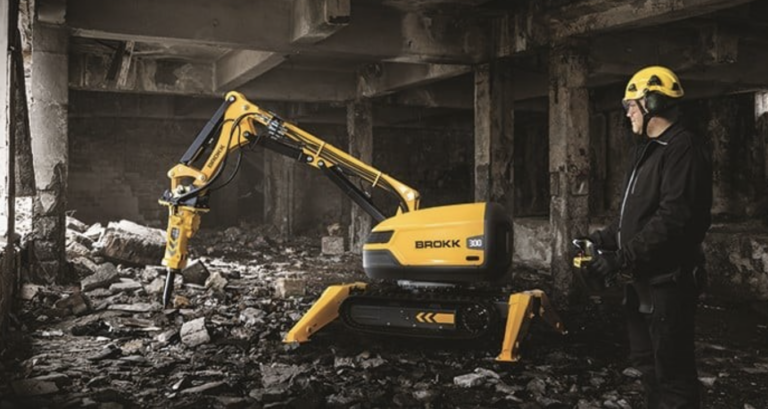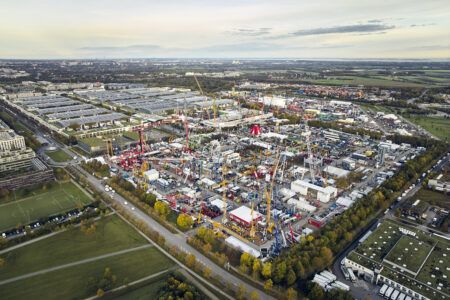Demolition is difficult, dirty, dangerous work. It is also necessary work. How best to keep workers safe in a demolition environment? Remove them from that environment.
When the persons come out, the robots move in. Robotic demolition has been soaring in popularity. Demolition includes razing structures, but a growing demand for demo comes from retrofitting and repurposing existing structures. That can be done by an operator on a skid steer with an attachment, but dust, fumes, falling debris, and other hazards have driven contractors to seek out other options to keep their workers safe; enter robotic options. There are also demolition settings where the fumes and oxygen consumption of diesel- and even propane-powered equipment are not allowed due to worker safety. Electric robots answer all these concerns.
Big-machine performance
While the use of electric robotics for demolition machines has risen recently, this nothing new to Brokk Incorporated, who’s product line focus is around remote demolition equipment. Lightweight and compact size are key for many of the jobs where Brokk robots are used, including interior demolition. Many models are within floor and elevator load limits, making transport and setup much easier. All models have lift points and can be craned into position, if necessary.
Since demolition robots are purpose-built for the task, their size and weight may not good indicators of their capability. Jeff Keeling, vice president of sales and marketing at Brokk states “It would typically take an excavator three times heavier than a Brokk equipment piece to deliver comparable breaker performance and our four smallest models fit through a standard doorway. We aren’t adding an attachment to an existing piece of equipment. We are designing purpose-built demolition machines for use in confined spaces.”
As is the case with Brook machines, demolition robotic machines are remote-controlled by radio and cable with a range of up to 1,000 feet.
Electric demolition equipment
Just as electrification is making waves in consumer vehicles and land-moving construction equipment, it continues to affect the future of demolition equipment. While Brokk offers diesel models where their use is appropriate, but their innovations specialize in electric. Power is supplied by plant or building power or by generator if sufficient plant power is not available. Brokk’s electric models require 480-volt service of 20 to 100 amps, depending on the model. Wire gauge also varies by model and length of run; Brokk provides guidance.
This raises a question: why not batteries? “Attachments are huge power consumers,” says Keeling, “and today’s battery technology limits run time to two or three hours, which is clearly not sufficient.” How is it other electric equipment has longer run times? Other machines have a lower draw, are hybrids, or have much larger battery packs. Brokk machines, with their emphasis on high power output from compact equipment designed for use in confined spaces, don’t lend themselves to hybrid power or massive, stacked batteries. In terms of the future of electrification for remote demolition equipment, Keeling states “We’re always monitoring battery development and it’s conceivable at some point we’ll be able to offer battery-powered models, but battery technology is not at that point yet.”
Market conditions for demolition
The switch to robotics has been a hot topic in the manufacturing industry for decades. “In the early days we’d hear, ‘You’re trying to take away our jobs,’” says Keeling. “Now we hear, ‘Please, help reduce our need for labor.’” With an ongoing labor shortage, especially a shortage of operators, customers want to cut their need for hourly workers and shuttle their remaining staff to tasks that provide more return to both the company and the employee.
Keeling says downtown renovations are big, with many buildings being repurposed to housing. There’s been a huge shift in the workforce recently, with many employees leaving traditional employment to pursue something else. Many that remain are working remotely, either by their choice or that of their employers. Estimates are that up to 30 percent of workers will be remote by 2025. Does this open up commercial properties for repurposing? “Not yet,” says Keeling, “Commercial property owners are taking a wait-and-see approach before reconfiguring their properties.”
Mention demolition to members of the general public and they recall media footage. Precisely timed detonation of charges. An office tower or casino or bridge turned from form and structure to rubble and dust in just seconds. But demolition work is rapidly morphing into something with more control, more finesse, but no less danger. Electric, robotic demolition machines answer the twin requirements of production and safety as this market continues to evolve.





